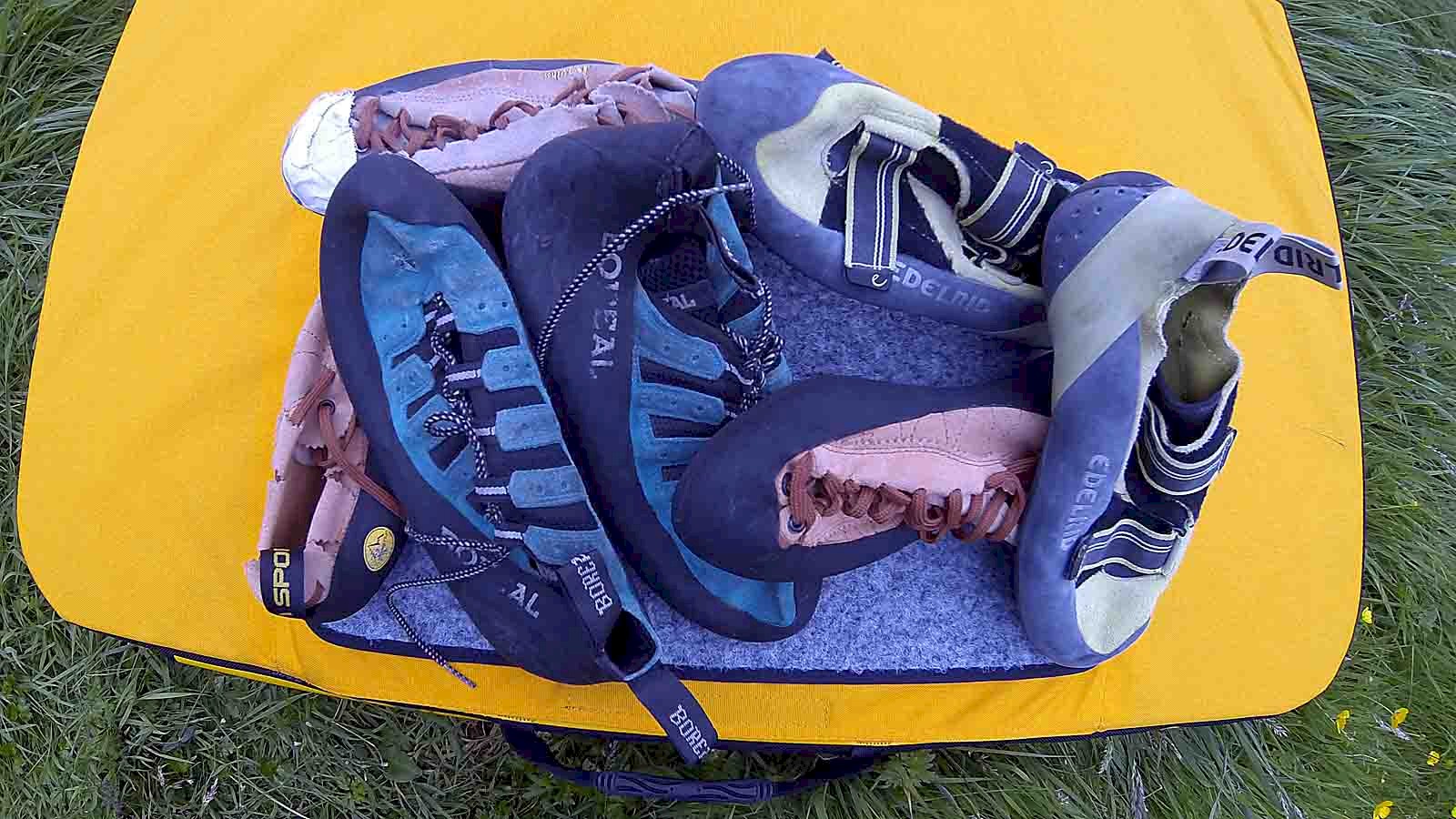To a climbing beginner the world of climbing gear is not only alien, but sometimes scary and almost always confusing. One of the first items of gear most beginners are going to buy are a pair of climbing shoes. Also known as "stickies", climbing shoes are a great improvement from the trainers most people start in. With this in mind, how do you choose a decent shoe that does the job, leaves your feet in a working condition, aids your climbing and doesn't require you to take out a mortgage?
Firstly, let's dispel some myths surrounding climbing shoes. These are often regurgitated by more experienced climbers when asked what to look out for, but largely do not apply to beginners choosing their first shoes:
- Climbing shoes should be X numbers smaller than your actual shoe size: It is true that climbing shoes often end up being half a size to two sizes smaller than your actual shoe size. Most climbing shoes will stretch after some use due to the materials used, but this is not guaranteed. Therefore buying half a size to a size smaller will usually mean the shoe fits better in the long term, but as a beginner ignore the numbers for now and find a (cheap) shoe that fits.
- If your feet don't hurt the shoe is too big: In theory, climbing shoes are meant to have a snug fit, but climbing shoes also aim to give you as much stability with as little bulk as possible. Importantly though, as a beginner you should be able to put on your climbing shoes at the start of your climbing day, take them off at the end and forget about them inbetween. That said a slight curl in your toes is common with climbing shoes as it allows for more pressure to be placed on the toe section, too aggressive a curl and your feet will soon complain though.
- The more arched/pointy/aggressive the shoe the better it is: Heavily arched, aggressive shoes are the domain of technical climbers, professionals and sadists. The more technical the shoe the more perfect your own technique has to be to get the most out of it. Without the technique, the all-important sole is going to be shredded in weeks and your money with it. Since more technical shoes tend to sport a softer rubber this only increases the speed of shredding.
- Lace/Velcro/Slippers are best: Honestly - it's personal preference which style you choose. Lace ups are most suitable for generic shoes, the kind you wear all day indoors as well as out. This is purely due to their flexibility and the lacing, which allows for comfortable adjustment to suit your foot. Lace ups also allow for slightly "odd" foot shapes, so if your feet don't conform to standard shapes give them a try. Velcro on the other hand is a classic choice for technical shoes that need to be adjustable but also don't stay on your feet for long. Boulderers and especially technical climbers will often be seen with these. An advantage of velcro is the simplicity allowing one handed adjustment, but this is rarely required. Slippers are non-adjustable but also require the least faff in putting them on. If you find a slipper shoe that fits by all means go for it, but most climbers prefer adjustable shoes.
With climbing shoes, as with any other piece of technical gear, the intended use plays a vital role in deciding what to look out for. The style of climbing is probably the most influential factor when buying any piece of kit and the same goes for shoes. Indoor climbers can take off shoes at any point allowing for a slightly more technical shoe without having to carry around other suitable footwear aside maybe from a pair of flip-flops for hygiene reasons. Indoor climbers also rarely wear socks with their shoes, although this is largely personal taste and preference.
Climbers venturing from the indoors to the outdoors often bring with them the indoor shoe attitude, but really in the outdoors wearing socks is a matter of comfort in any weather other than a hot summer day. Highly technical shoes that can be taken off at any time indoors are not often seen on climbs below the F6b and E1 mark – harder climbing for those who don’t know the grades yet. Personally, I have climbed outdoors for years in a trusty pair of Boreal Jokers. These shoes are the most non-technical pair I have ever owned, but since outdoor footwork is vastly different to indoor footwork the shoes have only let me down on occasion at the top end of my climbing spectrum.
To recap - as a beginner you want an all-round shoe, preferably one that can stay on your foot for a few hours at a time and one that's adjustable to fit your foot no matter how thick or existing your socks. An excellent shoe that has served me extremely well for the past 4 years is the La Sportiva Mythos. This shoe is probably the most technical, non-technical shoe you can find: It is comfortable enough to be worn all day, technical enough to improve your climbing and durable enough to last you for years.
So now you know what to look out for in a shoe, but how do you go about finding the right size and crucially the right price? These days you have two options:
- Buying in a shop: Outdoor shops no matter how big or small are a valuable source in the outdoor industry today. While the majority of people walk in, look around a bit and then simply buy the shiniest, cheapest or most colourful item, the expertise of the majority of outdoor retailers should not be underestimated. Most shops also provide the opportunity to "try" their products. For shoes this is often just a small selection of climbing holds on a plank of wood, but don't underestimate this as a shoe can feel completely different while standing on your whole foot to standing on the inner edge, outer edge, toe etc. A major disadvantage of physical shops is the greater overhead cost which is usually passed on to the customers. However, nothing is stopping you from trying a few shoes in a shop, going away and then looking up the same shoes online and buy them cheaper. Do look out for price matching offers though, especially bigger outdoor retailers tend to have these and they can make all the difference. More established outdoor retailers also often participate in discount schemes for BMC members or members of other organisations, so it pays to have a good look around. If you're buying a lot of kit in a year, then the price of membership to outdoor organisations can often be justified in the savings made.
- Buying online: Finding cheap deals is a breeze online compared to shops, but you are losing all the expertise a shop assistant would offer you. I have bought climbing shoes online before without having tried them in a shop beforehand, but I did have 20 pairs delivered and sent 19 back. Although it is easier to find offers and compare prices online many shops do not offer membership discounts unless you make a purchase in store. That said, this is changing steadily as the online market is growing ever bigger and more competitive. A major advantage of buying online is the protection the law gives you in terms of returning items (see the Which? website for more details on the "new" regulations). This means that you can feasibly wear a shoe for 3 hours while playing on the console and see if your foot starts hurting at any point. It also means that in theory you can use the shoe in a climbing center for a day and still return it, as long as you are happy to most likely not receive all your money back. Buy a shoe in the shop and all of this is only possible at the discretion of the shop.
All in all for your first climbing shoe I would recommend going to a reputable retailer, finding a knowledgeable shop assistant, explaining that you are looking for a comfortable all-round shoe and then finding the best fit. Since the savings when buying online are unlikely to be more than £20 unless you find an exceptional deal and given that a properly fitted and tried shoe will last you around a year longer than a bad fitting one, it is worth splashing out on the shop price.


Leave a comment